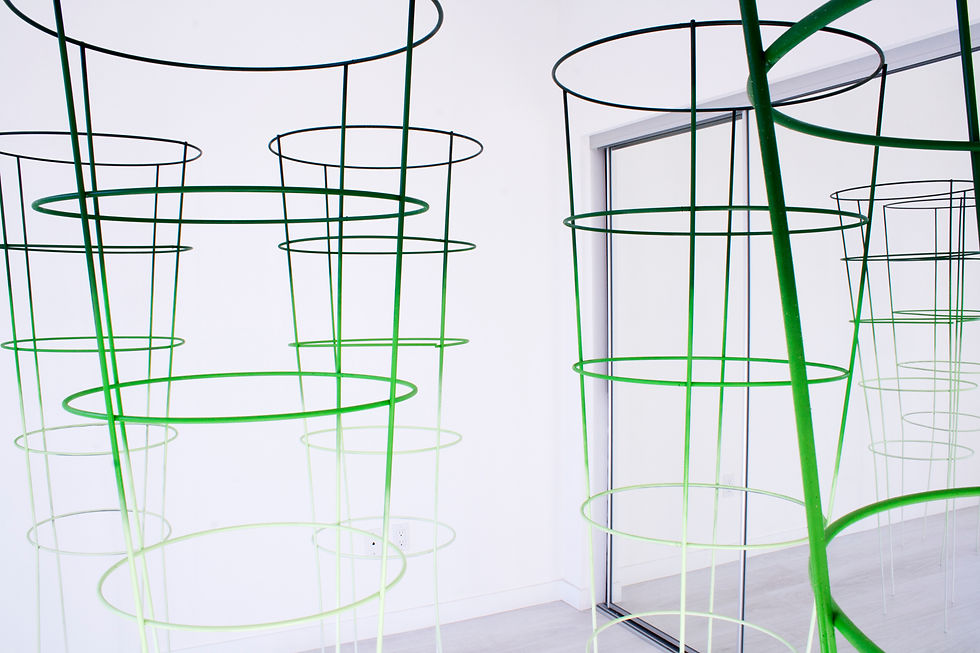PRESS RELEASE
I’ve often imagined Michael and Anthony at Anthony’s father’s bikini factory towards the end of the day, waiting impatiently for the seamstresses to clock out. Each punch would be one step closer to the evening’s program. I see them, seeing each other, hinting at what mischief and trickery they have planned. Each night the bikini factory became more than just the artists’ shared studio space. It became a theater set, a make-shift tent, a sandbox, a science lab.
Though working principally with different mediums, their individual practices have developed in parallel through their shared time in the bikini factory. And it’s through their individual works that I have taken the liberty to imagine their nights together.
Two photographs of Anthony’s come to mind. The first is the back of a plastic female torso form photographed in front of a band of black spandex. The result is an Escher-esque depiction of the bikini form, eerily resembling a muscle cuirass or even Man Ray’s rayograph of Lee Miller; the second photograph is of Michael’s back as he’s sitting on a fabric cutting table, arms lifted and his ass pressed so firmly down. His limbs are sharply cut from view, a visual that could have only been informed by the above mentioned bikini mannequin. And then there’s Michael’s piece Draft, a resin cast of Anthony’s brother’s freshly-waxed torso as they laid him down on that same fabric cutting table. The cast was then painted to mimic a photogram of a piece of school paper on a sunburnt chest.
These three pieces, along with many of the artists’ other works, are in a musical round with each other, sharing the same melody of trickery and illusion, time and the sun, its light, and shadows. Michael and Anthony are mimicking and then echoing their surroundings, surfaces, each other and each other’s work. Michael’s surreal relief paintings of domestic interiors, tree trunks and body parts capture and document those surfaces with a photorealist precision. Anthony’s photography is a continued exercise on the sleight of hand, using light and surfaces to manipulate visual realities into moods and emotions.
In recent years the artist-couple has begun to collaborate on a number of sculptural pieces, capturing their individual sensibilities into work that joshes with space, boundaries and obstacles. The sculptures reimagine and reconceive the indoor and outdoor and the artificial and natural in a wickedly playful manner which is evermore appreciated in the context of their shared studio space in the factory.
Michael and Anthony have since set up a studio-home and garden project, but it is in the same spirit of their shared nights alone in the bikini factory that they have come to the apartment. The title of their project, The Green Curtain, alludes to the curtain separating the illusion of the wizard from the man at the end of The Wizard of Oz. The reveal here, however, might lead to further intrigue and curiosity.
The north bedroom contains the second iteration in a series of installations of garden fences. The fences are acquired through a series of exchanges in which the couple takes down fences from strangers’ yards and installs new ones in their place. The west bedroom holds an arrangement of extra-large tomato vine cages, painted in a green-to-white gradient and creating the impression that they have sprouted from the white laminate floors. Both interventions in the guest bedrooms were installed over a single evening, only to be discovered by myself when I returned to the apartment the next day.
Michael Henry Hayden received his MFA from the University of Southern California, Los Angeles and his BFA from Cooper Union, New York. Recent exhibitions include Team Gallery, New York; M+B, Los Angeles; Galerie Xippas, Paris; ACME., Los Angeles; Steve Turner Contemporary, Los Angeles; LAXART, Los Angeles, among others.
Anthony Lepore lives and works in Los Angeles. He received his BFA from Fordham University in 2000 and his MFA from Yale University in 2005. His work has been exhibited internationally, from Los Angeles and New York, to London, Paris, Turin, Milan, and Shanghai, and is held in the permanent collections of the Guggenheim Museum (New York), the Los Angeles County Museum of Art (Los Angeles), the Hammer Museum (Los Angeles), the J. Paul Getty Museum (Los Angeles), the Kemper Museum of Contemporary Art (Kansas City, Missouri) and Yale University Art Gallery (New Haven, Connecticut), among others.


